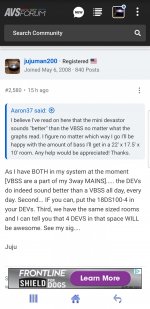True, however I wonder why the same economic considerations would not apply for companies as well... /QUOTE]
They do apply. But so do for logistics and storage. If you have to buy two more trucks, larger storage hall, more fuel, drivers, staff to move and service things, then size and power density matters incredibly. Go read/watch what B&C speakers and Powersoft say about their solutions. Exactly that. That is in their advertising.
So what metrics or properties is important to compare?
Distortion and efficiency.
I compared a BR with the LEAST efficient type of TH, yet the T-TQWT is able to get just as loud with 75 watts less power in the same size enclosure.
Indeed, and hope I do not misunderstand you here, but in this case we are talking about half the power need, and half the amount of drivers, this means less equipment (amps and drivers) to service and maintain, and the speakers them selves are the same size for very close to the same output in the same range, so how would could this not be a better solution even in that regard?They do apply. But so do for logistics and storage.
Before we continue I just need to get some things clarified to avoid misunderstandings, I'm clear on the difference between sensitivity and efficiency but what makes up the the term "power density"? is this dB/dm3 for a specified range? (just guessing).
Not to sink my own ship here, but I would assume there is a break-point in this somewhere, there usually is in all systems, one such would be that a BR can scale on SPL alone for a given LF corner by size, look at tiny 6,5" hifi speakers that reach 40Hz in a 10dm3 volume.
I believe the same cannot be said for higher order QW designs, they scale their LF corner along with size as it depends on certain path lengths with certain cross section areas, this impacts the size directly and is to some extent divorced from driver size which impacts cross section area only, which is only one part of what makes up the size, the other is the path lengths needed to reach the LF corner.
But I believe there is an interval where higher order QW designs can put up a pretty tough fight, perhaps even win, and do so with less power and less drivers, the question I ask my self is what that interval looks like, as always, I may be wrong in this.
I'm very happy to see that we're going into this detail. I am not big rental company, not even small one. I'm on thin ice here. Cannot give you real reasons, just ideas.
I gave you some already. If "very close" means few trucks, then there is the price for that and argument against it right there. Then who pays bills for electricity? Not the speaker owner I guess. Noone cares about power, it's not even a consideration. Speakers are reliable, and businesses replace them in the 2-6 years window. As long as these do not become very unreliable, noone cares how many of these are in the box. On this level, SPL is sold, not a speaker component.
Yes, power density is SPL/volume in the given range. People are after that quite a lot nowadays.
For some screwed up reasons, advanced designs are overpriced. I would hope it is the inertia and market size.
Advanced designs win in the SPL/Price category unless horrendous amount of money are asked for development and novelty. And of course, they are. There might even be some irrational reasons. But yeah, dev costs, economy of scale, prejudice, novelty costs, inertia, logistics, don't let me start on allowance of margin of error in production. You can eff up a horn with mistake of two-three milimeters, specifically for horn design. These aspects can make it wanted or unwanted in the eyes of these voting with their wallets.
Then, modularity. In medium systems, two guys or even one can handle compact bins. Not so for ROAR18 or EAW BH760, or large scoop. And you can do five venues with five smaller bins. Not so with two scoops.
Just ideas, not even opinions in this state.
I gave you some already. If "very close" means few trucks, then there is the price for that and argument against it right there. Then who pays bills for electricity? Not the speaker owner I guess. Noone cares about power, it's not even a consideration. Speakers are reliable, and businesses replace them in the 2-6 years window. As long as these do not become very unreliable, noone cares how many of these are in the box. On this level, SPL is sold, not a speaker component.
Yes, power density is SPL/volume in the given range. People are after that quite a lot nowadays.
For some screwed up reasons, advanced designs are overpriced. I would hope it is the inertia and market size.
Advanced designs win in the SPL/Price category unless horrendous amount of money are asked for development and novelty. And of course, they are. There might even be some irrational reasons. But yeah, dev costs, economy of scale, prejudice, novelty costs, inertia, logistics, don't let me start on allowance of margin of error in production. You can eff up a horn with mistake of two-three milimeters, specifically for horn design. These aspects can make it wanted or unwanted in the eyes of these voting with their wallets.
Then, modularity. In medium systems, two guys or even one can handle compact bins. Not so for ROAR18 or EAW BH760, or large scoop. And you can do five venues with five smaller bins. Not so with two scoops.
Just ideas, not even opinions in this state.
